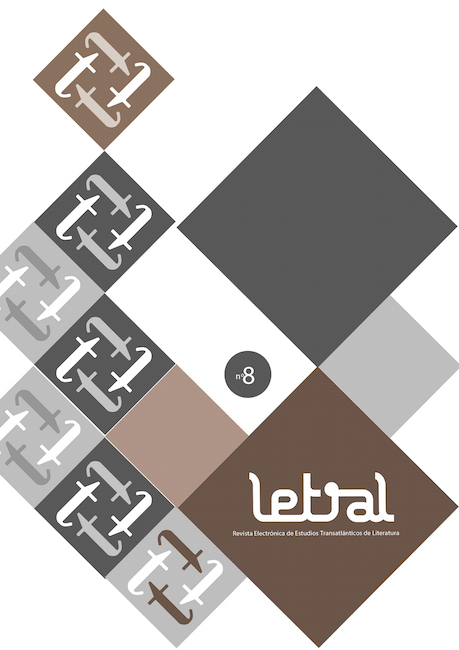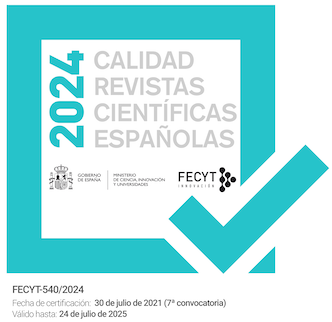Un híbrido de horror y belleza: La condesa sangrienta de Alejandra Pizarnik
DOI:
https://doi.org/10.30827/rl.v0i8.3687Keywords:
Pizarnik, Hybrid, Beauty, MelancholiaAbstract
La condesa sangrienta is a controversial textual artifact which Alejandra Pizarnik herself considered the peak of her style. It hybridizes some prose and poetry, some review and short story, some article and historical chronicle. And meanwhile the horror and beauty both merge to set the character of Erzsébet Báthory, the discursive axis from which the poetry of destruction will be built.Downloads
References
Darío, Rubén. Los raros. Madrid: Mundo latino, 1896.
Derrida, Jacques. La filosofía como institución. Editorial Juan Granica: Barcelona, 1983.
Cheng, François. Cinco meditaciones sobre la belleza. Madrid: Siruela, 2007.
Gutiérrez, Fátima. “El héroe decadente”. En Thélème. Revista complutense de estudios franceses, 15 (2000): 79-88.
Jackson, Stanley W. Historia de la melancolía y la depresión desde los tiempos hipocráticos a la época moderna. Madrid: Turner, 1989.
López Pérez, Mª Ángeles. “La (Re)presentación de la violencia (ponencia negra con argentinas)”. En Barrios, Olga (ed.). Realidad y representación de la violencia. Salamanca: Universidad de Salamanca, 2002.
Miguel, Amando de. Sociología de las páginas de opinión. Barcelona: ATE, 1982.
Montenegro, Rodrigo D. “La condesa sangrienta de Alejandra Pizarnik: una poética en el límite. El horror de la belleza; la belleza del horror”. En Espéculo. Revista de estudios literarios. 42, 2009. En http://www.ucm.es/info/especulo/numero42/condsang.html
Monzón, Isabel. Acercamiento al mito de la condesa sangrienta. Buenos Aires: Feminaria, 1994.
Penrose, Valentine. La condesa sangrienta. Madrid: Siruela, 1987.
Pizarnik, Alejandra. “La condesa sangrienta”. En Diálogos, 5, julio-agosto, 1965.
_____. “La condesa sangrienta”. En Testigo, I, 1, enero-marzo (1966): 55-63.
_____. La extracción de la piedra de la locura y otros poemas. Madrid: Visor, 1992.
_____. Prosa completa. (Ana Becciu (ed.)). Barcelona: Lumen, 2002.
_____. Diarios. (Ana Becciu (ed.)). Barcelona: Lumen, 2003a.
_____. Poesía completa. (Ana Becciu (ed.)). Barcelona: Lumen, 2003b.
_____. La condesa sangrienta. Barcelona: Zorro rojo, 2012.
Real Academia Española. Diccionario de la lengua castellana. 8ª ed. Madrid: Imprenta Nacional, 1837.
Toro, Alfonso de. “Borges/Derrida/Foucault: Pharmakeus/Heterotopia o más allá de la literatura (‘hors-littérature’): escritura, fantasmas, simulacros, máscaras, carnaval”. En Toro, Alfonso de/Toro, Fernando de (coords.). Jorge Luis Borges. Pensamiento y Saber en el siglo XX. Frankfurt: Vervuert, 1999.
Venti, Patricia “La traducción como reescritura en La condesa sangrienta de Alejandra Pizarnik”. En Espéculo. Revista de estudios literarios, 32, 2006. En http://www.ucm.es/info/especulo/numero32/pizventi.html
Downloads
Published
How to Cite
Issue
Section
License
Revista Letral is an open access journal under a Creative Commons Atribución-NoComercial 4.0 license.
The works published in this journal may be reused, distributed and publicly presented for non-commercial purposes, provided that: cite the authorship and the original source of the publication (journal, publisher and URL of the work).
We strongly recommended you to share our published articles in social and scientific networks, institutional and public repositories, personal or institutional websites, blogs, Google Scholar, ORCID, ResearchID, ScopusID, etc.
The journal allow the author(s) to hold the copyright and to retain publishing rights without restrictions.
We are completely free, both for readers and authors.














